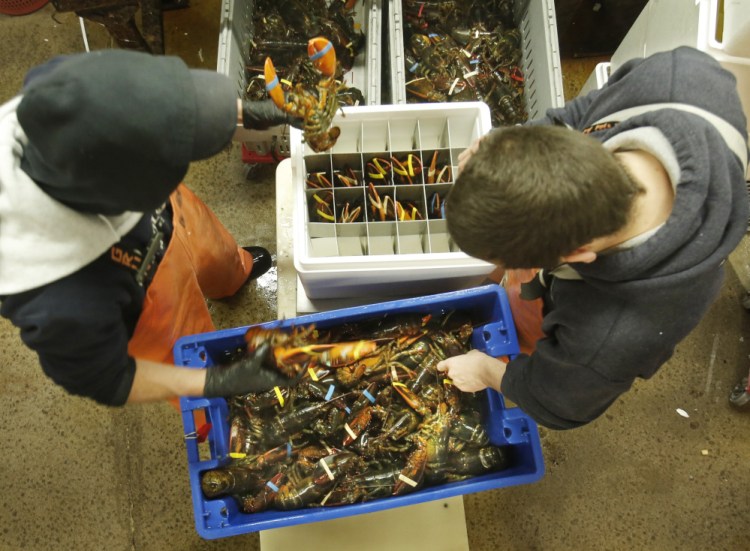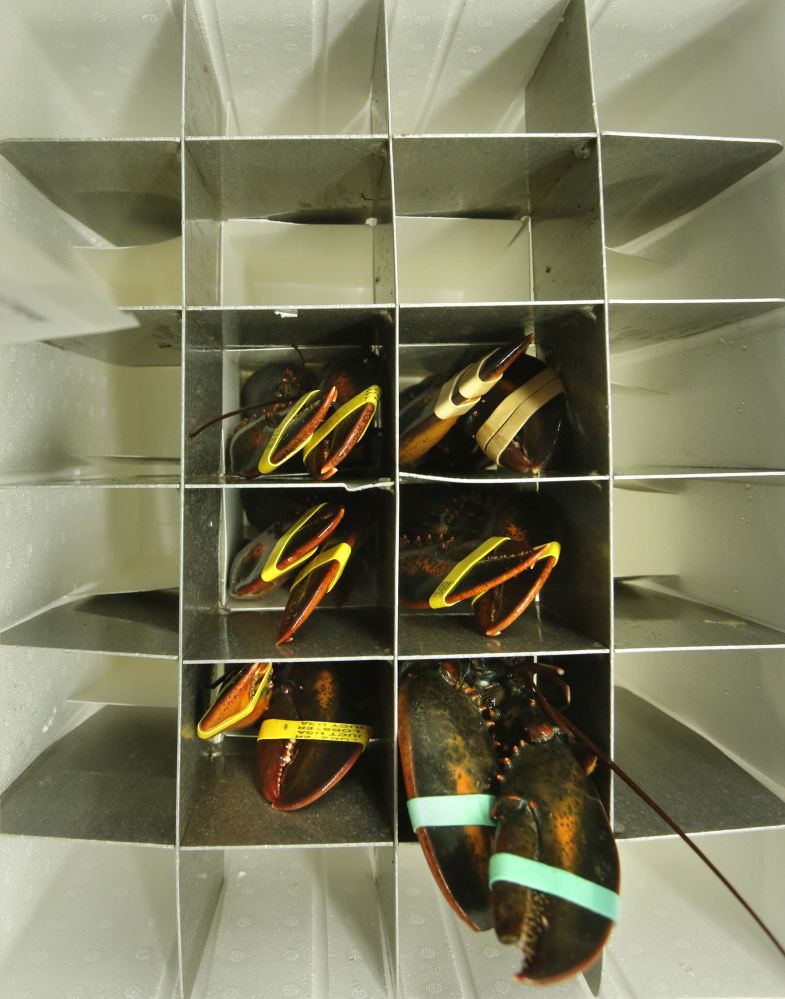The Chinese appetite for North American lobster is well known and getting bigger every year, but it may be twice as big as previously believed.
That’s because there is a lot more lobster ending up on Chinese dinner plates than what Canada and the U.S. send over. Researchers think there is even more North American lobster being traded along indirect and sometimes shadowy routes through other places in Asia, like Hong Kong and Vietnam, that eventually ends up as luxury eats for China’s growing middle class.
The implications could be significant for Maine’s lobster industry, says University of Maine research professor Joshua Stoll, a Down East native who has spent a few seasons lobstering himself. He and his Swedish counterpart, Beatrice Crona, are studying American lobster trade routes to China. Stoll presented their initial findings at an international lobster conference in Portland last month.
“Trade isn’t good or bad,” Stoll said. “But we should know who is buying our lobster and understand the risks. We could be in for a surprise.”
Stoll is referencing the volatility of China’s market, which can be as complicated as it can be lucrative. Just ask Norway salmon farmers. When the Norwegian Nobel Committee gave the Peace Prize to Chinese dissident Liu Xiaobo in 2010, Norway’s share of China’s big salmon market collapsed, with shipments delayed for weeks by Chinese safety inspectors who called it an unhealthy fish.
A political dust-up like that could, if applied to American lobster like it was to the Norwegian salmon, wreak havoc on Mainers up and down the lobster supply chain. The market would eventually recover, and dealers would find another market for their lobster, but prices would likely drop, and that would be painful for all involved, from lobstermen to boat builders to the people who sell them cars or houses.
GLOBAL EFFECTS
The largest lobster price drops over the last 25 years can be traced back to international events, Stoll said. Prices fell in 2001, after the World Trade Center attacks changed flight and cargo shipping patterns, he said. They fell again in 2007-08, during the global recession, and in 2012, when an early molt led to a spring glut that had Canadian lobstermen blocking routes into Canadian processing plants to stem the oversupply.
To get a sense of how seriously the Maine lobster industry takes international trade, one only has to look at how the industry responded when Sweden wanted to dub the North American lobster an alien invasive species, which would have killed the live lobster trade to Europe. Dealers asked their European buyers to protest. Scientists lined up to discredit the claim. Lawmakers threatened to go to the World Trade Organization.
But as the EU flap proved, all international trade involves risk, said Annie Tselikis, director of the Maine Lobster Dealers Association. It is a risk the industry is willing to take to expand beyond what used to be a wholly domestic market, she said. Fifty years ago, a highly perishable product like American lobster was rarely eaten more than a day’s drive from New England, she said.
Improved shipping technology and logistics and an effort to open up worldwide markets have led to record landings and value for Maine’s top fishery, Tselikis said. In 2016, Maine lobstermen hauled in a catch valued at $547.2 million, including lobster cooperative payouts, which is the industry’s biggest year ever, according to state records. To compare, 25 years ago, Maine’s lobster fishery was valued at about $71.8 million.
Jeff Bennett of the Maine International Trade Center, who specializes in lobster trade, doesn’t think the lobster trade to China poses a risk unless China was willing to pay a lot more for lobsters than other potential buyers, and he thinks that’s unlikely to happen because China buyers still negotiate on lowest price. That is changing, but only a little bit, he said.
“With high domestic demand and demand from Canada, Europe and other markets, I don’t think we’ll get to the point of China importing the vast majority of our catch,” Bennett said. “U.S. suppliers are savvy enough to mitigate their risk by selling to multiple markets and multiple distributors.”

Dan Warner carries a foam container of live lobsters to an insulated shipping container at The Lobster Co. in Arundel in 2014.
VARIOUS ROUTES TO CHINA
In 2014, United Nations trade statistics show the U.S. and Canada exported $131 million worth of lobster directly to China, Stoll said. They exported another $47 million worth to nations that turned around and resold it to China, statistics show. That kind of secondary trade increased China’s documented North American lobster market to $178 million, which is about 9.9 percent of total U.S. and Canadian lobster exports.
A prime example of this kind of secondary trade is Hong Kong, Stoll said. The U.S. and Canada exported $55.7 million worth of North American lobster to Hong Kong in 2014, according to U.N. trade statistics. Of that, Hong Kong reported exporting $11.9 million worth to China that year. The former British colony has always been a gateway to China, with Western-style business practices and long trading relationships, Tselikis said.
This secondary trade probably happens for several reasons, Stoll said. Sometimes it is cheaper to buy a shipment of lobster through another country because of high tariffs like the ones that China had in place on American lobster back in 2014. China has just reduced its lobster tariff from 15 to 10 percent, which will likely make secondary trade less attractive in the future, Tselikis said.
American dealers have also gotten to know their Chinese buyers better, which facilitates easier direct trade, Tselikis said.
Stoll suspects there is also a lot of “gray trade” of North American lobster to China, or what others might call black market trade. That might have added $120 million to the North American lobster market in China in 2014, boosting it to as high as $298 million. That’s more than twice what the U.S. and Canada export directly to China, and about 16.5 percent of all U.S. and Canadian lobster exports in 2014.
A CRACKDOWN ON BLACK MARKET
The U.N. doesn’t track gray trade because it is not reported to the governments, possibly to avoid tariffs, long waits in unrefrigerated facilities or to get around not being listed on exclusive shipping lists. The data can point researchers like Stoll toward likely gray or black trade routes, however, where there has been a long history of back-door seafood trade to and from China.
Vietnam is a likely example of this kind of trade, Stoll said. In 2014, Vietnam bought $60.8 million worth of North American lobster from Canada and the U.S., but reported selling only $16,500 worth to China. During a visit Stoll made to China last year, however, multiple sources talked to him about a much more substantial trade route through Vietnam, representing millions of dollars of North American lobster.
Not all lobster exported to Hong Kong and Vietnam from the U.S. and Canada ends up in China, Stoll said. Undoubtedly, at least some of this luxury product is imported for consumption, especially in the upscale Hong Kong hotels. The real size of the North American lobster market in China in 2014, the latest data available when Stoll began his study, falls somewhere between $178 million and $298 million, he said.
American lobster dealers who ship to Asia say China has cracked down on black market or gray market trade through countries like Vietnam. John Norton, the president of Cozy Harbor Seafood in Portland, said he prefers to ship to Hong Kong because there is a “real rule of law” that doesn’t exist on the mainland. He doesn’t think his lobsters end up diverted to China, nor do many that go through Vietnam anymore.
“China cracked down,” Norton said. “So not as big of an issue as in the past.”
As Chinese infrastructure improves, secondary and back-door trade into China will undoubtedly evolve into direct trade routes, Tselikis said.
“The lobster trade to China is pretty established now,” Tselikis said. “They’ve improved their distribution chain, more refrigeration, more flights into the country, tariffs are dropping. Of course, there is still risk. There will always be risk. But it’s also a tremendous market the dealers have worked hard to open up.”
Penelope Overton can be contacted at 791-6463 or at:
poverton@pressherald.com
Twitter: PLOvertonPPH
Copy the Story LinkSend questions/comments to the editors.





Success. Please wait for the page to reload. If the page does not reload within 5 seconds, please refresh the page.
Enter your email and password to access comments.
Hi, to comment on stories you must . This profile is in addition to your subscription and website login.
Already have a commenting profile? .
Invalid username/password.
Please check your email to confirm and complete your registration.
Only subscribers are eligible to post comments. Please subscribe or login first for digital access. Here’s why.
Use the form below to reset your password. When you've submitted your account email, we will send an email with a reset code.